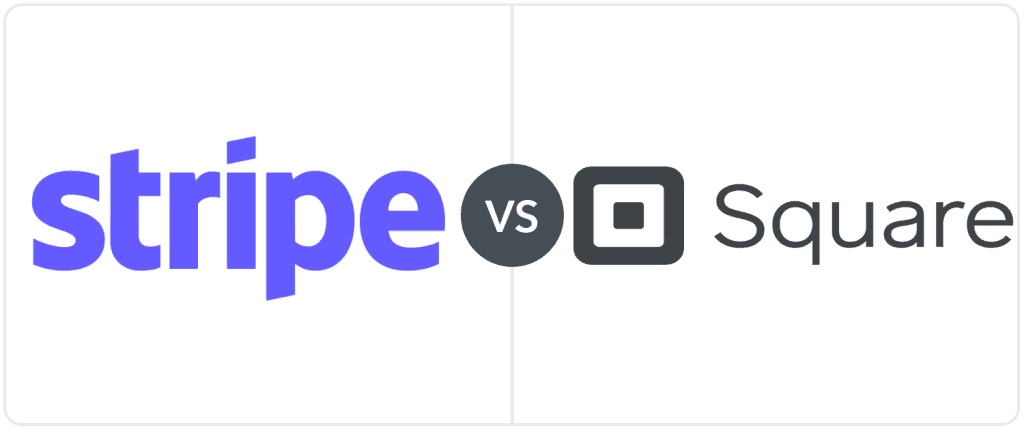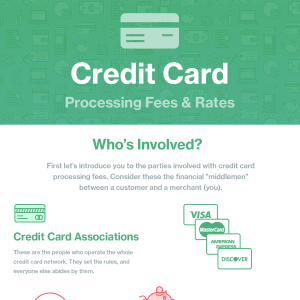Square dominates in-person payments while Stripe excels at international eCommerce, but if you only need a basic online store, the better choice is less obvious.

|
Stripe |
Square |
| Ideal For |
- Merchants with access to a developer/strong technical skills
- Merchants who sell mostly online with occasional in-person needs.
- Merchants who want a large choice of shopping carts
|
- Merchants with minimal technical skill
- Merchants who sell primarily in person but want eCommerce as well
- Merchants who want a seamless experience between in-person and online sales
|
| Pricing |
- 2.7% + $0.05 per in-person transaction
- 2.9% + $0.30 per online transaction
- 0.8% per ACH transfer
|
- 2.6% + $0.15 per in-person transaction
- 2.9% + $0.30 per online transaction
- 1% per ACH transfer
|
| Supported Online Payment Methods |
Credit cards
ACH
Google Pay
Apple Pay
Buy Now, Pay Later
International payment methods |
Credit Cards
ACH
Apple Pay
Google Pay
Buy Now, Pay Later
International payment methods |
| Includes Free Website |
|
|
| Standout Features |
- Customizable checkout
- Dynamic currency displays & conversion
- Extensive developer support
- Reduced fees for non-profits
|
- Free Weebly-powered online store
- Powerful inventory & customer management
- Extensive developer support
- Excellent, affordable hardware options
|
| What’s Missing |
No ready-made POS for in-person sales
First-party support for non-technical users |
Extensive support for international sales
Reduced fees for non-profits |
Stripe VS Square At A Glance
Stripe and Square, despite occupying different niches in the payment processing industry, are often compared to one another due to their similar pricing models and all-inclusive approach to services.
Square and Stripe take a similar approach to credit card processing. Both are third-party processors or payment service providers (PSPs). Rather than giving each business its own merchant account, all merchants’ payment processing is aggregated into large, communal accounts. As PSPs, they assume the risk associated with maintaining the accounts.
The advantage of this is that you–the business owner–can sign up and start accepting credit cards more quickly than you could with a merchant account. Unfortunately, it also makes troubleshooting anything going on with your account more difficult, which can result in more frequent account holds and freezes. It also means that neither Stripe nor Square can accept high-risk businesses, although Square does make allowances for CBD merchants.
Where Stripe Wins
- Excellent developer tools and customizability
- Exceptional subscription tools
- Ideal for international merchants
Stripe (read our full Stripe review) is an eCommerce payment processor, first and foremost. As such, most of its toolset is focused on card-not-present transactions. That means increasing the reach and security of your sales channels. In Stripe’s advanced features, you’ll find enhanced security, billing and invoice, subscriptions, and support for international payment methods and currencies.
Stripe’s developer-centric platform also makes it quite malleable, whether you’re setting up your own payment system or using an eCommerce service that uses Stripe as its integrated payment platform.
Where Stripe Falls Short
- Needs technical skills or third-party software to implement
- It can get expensive if you’re using a lot of advanced features
- Limited support for in-person transactions
Stripe is geared first and foremost toward developers who will implement its toolset directly into their company’s payment processes or their own eCommerce service. You don’t need to be a programming genius to use Stripe, but having someone on your team who can play under the hood with the code is important if you want to get the most out of it. Otherwise, you’ll need to get Stripe pre-integrated into a platform like Shopify.
The ideal Stripe customer primarily does business online and internationally. Stripe does provide some limited ability to take in-person transactions through Stripe Terminal, which supports a handful of mobile readers and Tap to Pay, but these aren’t intended to be your primary use case for the service. Think of an online retailer or freelancer who occasionally sells at conventions or shows.
Where Square Wins
- Easy entry point into credit card processing
- Affordable hardware
- Free website for eCommerce
Square (check out our full Square review) is about accessibility and convenience, particularly where new small businesses are concerned. For more advanced features, Square has conveniently divided its software into categories pertaining to various industries, such as Square for Restaurants and Square for Retail. All-in-all, it’s one of the quickest, cheapest, and low-risk ways for brand-new businesses to experiment with credit card processing.
Square started with a focus on point-of-sale (POS) transactions, but Square’s eCommerce offerings should be more than adequate for brick-and-mortar businesses that also make online sales. The offer of a free website makes Square a solid choice, even for businesses that never intend to make an in-person sale.
Where Square Falls Short
- Limited international payment support
- No single-account support for multiple currencies
- Not suited to larger businesses with high volumes
Square’s focus on accessibility may be great for new businesses, but there are a lot of ways merchants can outgrow Square. Square’s feature set is designed to be a nice, convenient package for businesses that don’t have their own software in place for things like employee management, inventory, and scheduling. Businesses that already have those needs covered won’t find Square’s value proposition to be quite as good.
Where Square’s limitations relative to Stripe really come into focus is with international transactions. Square doesn’t do currency conversion, nor does it support most foreign payment methods.
Stripe VS Square: Pricing Comparison
|
Stripe |
Square |
| Monthly Fee |
$0 – $10 (for custom domain) |
$0 – $69 (for premium services) |
| Online Transaction Cost |
2.9% + $0.30 |
2.9% + $0.30 |
| In-Person Transaction Cost |
2.7% + $0.05 |
2.6% + $0.15 (2.6% + $0.10 with some specialty POS packages) |
| Keyed/Virtual Terminal Transaction Cost |
3.4% + $0.30 |
3.5% + $0.15 |
| Payment Link/QR Code Transaction Cost |
3.3% + $0.30 |
2.9% + $0.30 |
| ACH Payments |
0.8% (maximum $5) |
1% (minimum $1) |
| Chargeback Fees |
$15 |
None |
| Invoicing |
0.4%-0.5% per paid invoice |
3.3% + $0.30 (Free-$20/month) |
| Refunds |
No additional charge, but Stripe keeps the original transaction fee |
No charge |
| Card Readers |
$59-$249 |
Free-$299 |
In terms of fees, Stripe and Square are both incredibly transparent. Both companies process online transactions at 2.9% + $0.30 with no monthly fees. Additional charges may apply for merchants who opt into either company’s premium products. However, both Square and Stripe readily disclose these costs.
Despite both companies using flat-rate pricing models, they do take a slightly different approach to gating features. Square, for example, tends to park them behind monthly fees. Stripe, on the other hand, adds supplemental per-transaction fees when the feature is used.
Which Is Cheaper, Stripe Or Square?
Despite very similar pricing models, Square is likely to be the cheaper option for most small businesses just because it offers so much for free. You won’t necessarily save on transaction costs, but little perks like no chargeback fees, free refunds, and a free website can add up. That said, at the granular level, costs for individual businesses can vary greatly once premium features come into play.
Some notes:
- For in-person transactions, Stripe is cheaper for transactions under $50 and Square for transactions over $50. Just remember that Stripe’s POS infrastructure is very limited. Hardware is similarly priced where the two companies overlap, the main difference being that Square offers customers one free Magstripe mobile reader.
- Stripe comes out ahead on ACH payments and will probably be a slightly better value if you do a lot of recurring billing. On the other hand, Square’s lack of chargeback fees and completely free refunds can add up to a lot of savings over time.
- Premium POS subscription services from Square can add a substantial monthly cost but save you money if you’re processing a lot of transactions. Make sure the math checks out for you.
- Stripe mostly does away with monthly fees entirely and instead adds per-transaction costs for premium features. These can add up if you’re using them frequently, so make sure they’re things you need.
You can read more about Stripe’s fee structure in our complete guide to Stripe pricing, or check out our complete Square pricing guide for more on Square’s fees.
Square VS Stripe: Features Comparison
|
Stripe |
Square |
| Mobile POS |
Stripe Terminal |
Square POS |
| Mobile Card Readers |
- Stripe Reader M2: $59
- BBPOS Chipper 2x BT: $59
|
- Square Reader: $0/first , $10/additional
- Square Contactless Reader: $49
|
| Free eCommerce Website |
|
|
| Billing |
|
|
| Invoicing |
|
|
| Invoice Templates |
|
|
| Developer Tools |
|
|
| Inventory Management |
|
|
| Payment Links |
|
|
| Buy Buttons |
|
|
| Downloadable Reports |
|
|
| Virtual Terminal |
|
|
| Recurring Payments/ACH |
|
|
| Regional International Payment Method Support |
|
|
| PayPal Integration |
|
|
| Marketplace Solutions |
(Stripe Connect, basic features included with an account, advanced features cost $2/month plus 0.25%+$0.25 per payout) |
(Square for Restaurants, Square for Retail, Square Appointments, available in free and premium versions) |
| Advanced Security |
(Stripe Radar, included with standard accounts; otherwise, $0.05 per screened transaction) |
(Square Risk Manager for an additional $0.06 per transaction) |
| Loans |
|
|
| Gift Cards |
|
|
In broad strokes, Stripe and Square have a lot of similar features, but the depth and implementation of these features can vary quite a bit.
Square offers suites of tools that it packages by industry. This can make it easy for businesses that aren’t very familiar with payment processing to select a package that should be oriented to their needs. On the other hand, Stripe’s tools are more like layers users can pile on to add additional functionality to their base credit card processing services. Stripe’s approach is more geared toward businesses that know exactly what they want, whereas Square’s is friendly to businesses that may be figuring that out as they go.
And while there is a lot of overlap between features, it should be stated that Square has more depth for managing your business’s offline goings-on. Stripe, on the other hand, has more depth when it comes to fine-tuning your online transactions and billing, and completely blows Square out of the water when it comes to selling across borders.
Setup
As mentioned, accessibility is one of Square’s big selling points, so you can expect a guided and pretty straightforward signup process that culminates in selecting where you’d like your free Square Reader shipped. How complex it gets from there depends on what features you want to utilize. Square generally makes setup as painless as possible, but the huge ecosystem can take some time to learn and navigate. eCommerce plugins are available for businesses that need them, and developers can use Square’s APIs to set up payments if customization is needed.
Stripe setup, on the other hand, will be a very different experience depending on whether you are using a white-label version of the service or are setting it up yourself. In the latter case, you don’t necessarily have to be a developer, but doing anything more than copying and pasting code into your website to get a basic hosted payment page up and running may take some technical knowledge. That said, Stripe’s documentation is exhaustive, so you don’t need to be a code ninja to get things going.
Credit Card Readers
In the past, this would just be a description of Square’s hardware, with Stripe Terminal-compatible readers as an afterthought. However, with the debut of its proprietary M2 reader, Stripe seems quite serious about getting into the hardware business.
Both Stripe and Square offer a selection of similarly priced and featured mobile and contactless credit card readers. As you might expect, Square’s line-up is deeper — Stripe doesn’t have anything comparable to Square’s free (if obsolete) magstripe reader or full-fledged POS systems like Square Register. Setting up Stripe Terminal is also a significantly more complex undertaking than setting up a Square card reader.
Billing & Invoicing
Both Stripe and Square are among our picks for best recurring subscription management. In both cases, invoicing is available with the basic and premium versions. Traditionally this has been more of Stripe’s wheelhouse than Square’s, but Square’s invoicing features are now quite robust so long as you don’t need to do a lot of customization.
Square offers unlimited invoicing with both of its plans, but adds some automation features for an additional o.01% settlement fee. With this formula, Stripe has the potential to be both cheaper and more expensive depending on the number and value of invoices you send each month and the features you want to use.
Developer Tools & APIs
As “full-stack” payment services, both Square and Stripe offer excellent APIs for any developers on your staff. It’s not so much a matter of which service better supports developers but which ecosystem better suits your business.
Stripe is much loved by developers for its flexibility, extensive documentation, and support for multiple programming languages, both on the web and in mobile apps. Stripe Elements will let you create an entirely custom form with prebuilt components, while Stripe Checkout generates a pre-built form you can just drop into the site with a few lines of JavaScript. In addition to mobile web and in-app payments, Stripe offers a host of APIs for other functions.
Despite being targeted toward a non-technical audience, Square doesn’t leave developers out in the dark. The Square ecosystem is enormous and extends far beyond payments, and Square offers API access to most of it, as well as software development kits for web payments, in-app payments, readers, and POS systems. Documentation is solid and thorough, even if it doesn’t quite reach Stripe’s level of accommodation.
Capital
Yes, capital, as in loans. Payment processing services, such as Square, Stripe, and PayPal, have started offering their customers financing. It’s not as strange as it sounds. Payment processors have a pretty good idea of what your revenue looks like and the infrastructure to collect payments on any debt they issue. While both companies call their products loans, they actually function a bit more like merchant cash advances. That is to say, they’re repaid by your payment processor taking a percentage of your credit card sales until you’ve repaid the amount you were extended, plus a flat fee.
I wouldn’t recommend choosing either service based on their Capital program: it’s more of a perk than anything. Stripe’s service is reportedly faster, but Square offers high borrowing amounts. Neither company lists a range of fees, but both use 10% as an example.
Ancillary Services & Software
One of the bigger draws of platforms like Square and Stripe are the services they provide beyond payment processing. Square, for example, can provide inventory management, scheduling, and some limited banking features.
Stripe, on the other hand, tends to provide infrastructure and enhanced security options. This includes options like machine learning for fraud prevention, tax automation, and data pipelines.
Additional Financial Services
Square has branched out into alternative banking via Square Banking, a service that can grant faster access to funds and allow you to process transactions without a business bank account and spend funds via a Square debit card.
Stripe’s financial services are more limited, but it does offer a corporate credit card and tools that financial institutions can use to offer their own services.
Which Is Best For My Business: Stripe Or Square?
As two of the best credit card processing companies, Stripe and Square both provide a lot of value within their specific niches.
Square is a spectacular all-in-one processor with ready-made solutions. You can sell in a store, on the go, and online — and get all your information, payments, and orders collected in one simple, intuitive dashboard. A vast array of add-on products allow you to consolidate a host of business functions under one name, and they’re guaranteed to work together perfectly. If you have limited technical knowledge, Square is going to be much easier to get started with.
Stripe Payments focuses on internet commerce (both on the web and in-app), but its tools make it possible for businesses to cater to customers all over the globe.
Stripe’s international focus — from the local currency displays to the sheer breadth of payment methods accepted — makes it clear that Stripe’s reach far exceeds that of Square, on the other hand. Not only that, but with Stripe’s APIs and documentation, a savvy developer could create all kinds of payment customizations for a business. Business owners who don’t have a developer on staff and don’t have a lot of technical knowledge themselves may initially struggle with understanding how to use Stripe, especially if they want to do more than integrate it with shopping cart software.
Choose Square If…
- You Run A Brick-&-Mortar Business: If you only do some of your business online, you’ll likely benefit more from Square’s POS infrastructure, software, and hardware.
- You Want An Easy-To-Use Solution: Not a developer? Don’t know any developers? Don’t want to know any developers? Square is designed to get you up and running quickly, with access to popular integrations as well.
- You Want Productivity & Management Support: Square offers a lot of tools to help you manage your company and your customer base.
Choose Square Payments
Choose Stripe If…
- Your Business Does International eCommerce: Stripe’s support for multiple currencies and payment methods makes it a better choice for companies doing business globally.
- Your Business Is Completely Or Mostly Online: While you can use Stripe for POS, that’s not where it shines. Its ecosystem is optimized for online transactions.
- You Have An In-House Developer: Stripe is made with developers foremost in mind. Whereas this can sometimes make it inconvenient for laypeople, a programmer or two should be able to get it up and running with little effort, thanks to Stripe’s extensive documentation and tutorials.
Choose Stripe Payments













